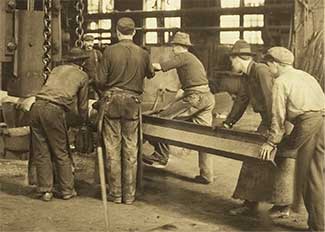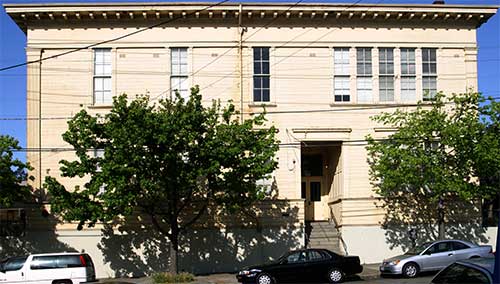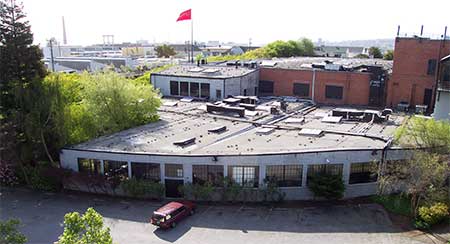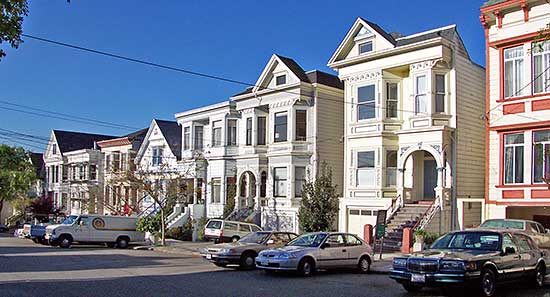
Overview
by John Borg
Dogpatch is a slice of San Francisco with a
distinctive and colorful history, a history tied closely to the
once-booming industrial economy centered in the city's Central
Waterfront.
Located on the flats east of Potrero Hill,
Dogpatch is an approximately nine square block area, generally bounded
by Mariposa Street to the North, Tubbs Street (23rd) to the South,
Highway 280 to the West, and Illinois Street to the East.

Dogpatch contains architecturally and
historically significant workers' cottages, factories, warehouses and
public buildings constructed between 1860 to 1945. It is one of the few
neighborhoods to survive the 1906 earthquake and fire, and it is gateway
to the oldest, largest and most intact historic industrial complex
remaining in the city–the former shipyards and mills on the waterfront
at Pier 70.
A Neighborhood for Working People
The Gold Rush, starting in 1848, is undoubtedly the most well known event in California history. By 1852, two years after California joined the United States, San Francisco had been transformed from a sleepy outpost into a great world seaport and metropolis, with a swelling population of mostly young men out for the adventure of their lives. Some of them eventually ended up working in thriving industrial enterprises in the Central Waterfront.
The earliest
enterprises in the area began on a lonely patch of land protruding into
the bay at Point San Quentin, later known as Potrero Point.
 |
An 1862 photo of Potrero Point by Eadward Muybridge. The men in the foreground sit near what would now be around Illinois St. and 19th at the Eastern edge of Dogpatch. The landscape has changed dramatically over the years as hills were leveled, docks were built, and portions of the bay were filled in for further industrial development. Note the early dwellings on Irish Hill in the background. |
By
the late 1860s the area had developed into the City's most dense and
important center for heavy industry, employing thousands of industrial
workers and skilled craftsmen.
 |
It was during this
period that the Dogpatch neighborhood sprang up, established initially
by young Irish, Scottish, and English immigrant workers. Later waves of
immigrants settling in Dogpatch included Italians, Scandinavians,
Mexicans, Dust Bowl migrants, and African Americans.
|
Industrial
development of the Central Waterfront and the establishment of Dogpatch
and Potrero was fueled by the availability of cheap land and the opening
of Long Bridge, a wooden causeway across Mission Bay completed in 1865.
 |
The bridge stretched over the Mission Bay marsh lands, through the Islais Creek basin to Hunters Point, terminating at the ornate Bay View Race Track. Long Bridge covered what is now Third Street (known at the time as Kentucky Street). The construction of Long Bridge successfully connected downtown San Francisco to the Central Waterfront, but it had the environmental effect of sealing off the larger western part of Mission Bay, leading to the eventual filling in of the tidal lagoon. |
A Rare Glimpse of the Past
In many ways Dogpatch resembles the mixed
industrial/residential districts that existed throughout the vast South
of Market area before the 1906 Earthquake and Fire swept them away.
Thanks to its then-isolated location and protection from the marshland
that surrounded it, Dogpatch managed to escape the disaster. As a
result, it contains housing considered ancient by San Francisco
standards. Dozens of rare and architecturally significant buildings and
homes built between the late 1860s and 1910 can be found scattered
throughout the neighborhood today.

Most houses in Dogpatch were built by
working families, often with their own hands. Typical of the Dogpatch
neighborhood homes are more than a dozen quaint Victorian-style houses
designed by the architect Jon Cotter Pelton Jr. in the early 1880s. At
the time, Pelton published his design specifications for free in the San
Francisco Evening Bulletin, so homes could be built at a price that was
within the industrial worker's reach. Thirteen of these dwellings can
still be found in Dogpatch, on Tennessee and Minnesota Streets, between
22nd and 20th.

San Francisco's oldest existing public
school building, Irving M. Scott School, was built in 1895 to serve the
children of Dogpatch. The three-story wooden structure, named for the
head of the nearby Union Iron Works ship yard, still stands at 1060
Tennessee Street. Just up the street at 1009 Tennessee is one of the
City's oldest firehouses. A handsome two-story brick building, San
Francisco Firehouse No. 16 was originally constructed in the late 1890s,
when fire wagons were powered by teams of horses.
According to a 1999 survey conducted by
the Foundation for San Francisco's Architectural Heritage, the residents
of Dogpatch rented or owned their housing in nearly equal proportions
until after World War II, when absentee owners began to buy up the
housing stock. Almost three-quarters of heads of households in Dogpatch
worked for one of the district's large employers, such as Union Iron
Works/Bethlehem Steel, the Western Sugar Refinery, and Tubbs Cordage
Company.
All of the existing historic buildings
and culturally significant artifacts remaining in Dogpatch have been
carefully researched, photographed and cataloged by volunteers from the
neighborhood and the Foundation for San Francisco's Architectural
Heritage. Together, they succeeded in having the neighborhood officially
declared an historic landmark district.
Decline and Renaissance
By the mid-1940s, the Central
Waterfront's glory began to fade, and Dogpatch was hard hit by a 1ong,
slow period of industrial decline. The local shipbuilding industry died
out after World War II. The maritime industry diminished as shipping
went to bigger, more modern ports in Los Angeles, Oakland and Seattle.
Factories closed. Workers moved away, and many homes and factories were
demolished. By the 1950s and 1960s, Dogpatch gradually changed from a
proud working- class community into a physically blighted area.
The Dogpatch neighborhood began to
experience an urban renaissance of sorts in the late 1970s, at a time
when arson, decay and demolitions were reaching epidemic proportions. A
diverse collection of people, including many artists and creative
professionals, purchased run-down but affordable Victorian cottages and
Edwardian flats in the area. They fixed up the neglected properties and
transformed the once-dying area.

New types of business and industry
discovered the special charm of Dogpatch, and moved in, too. Esprit
Corp. transformed an old wine warehouse on Minnesota Street into the
headquarters of a world renowned fashion and lifestyle company.
Gentrification had begun.
By the
mid-1990s, after twenty-five years of gradual change, a rapid wave of
development started taking place, mostly in the form of "live-work"
loft units. Hundreds of these units were built in a few
short years. Much of the development occurred on empty lots, but by the
late-1990s preservationists noted a disturbing trend taking place:
historic structures and warehouses were being destroyed to make way for
new loft developments. Large new loft buildings, combined with the
continued dis- placement of industrial workers and businesses, began to
seriously change the scale and character of the neighborhood.
Other major projects nearby made
Dogpatch even more attractive to developers, includ ing PacBell Park,
the UCSF Research Center, and Mission Bay, the largest-ever mixed use
project ever approved in San Francisco. A new high-capacity light-rail
line along the Third Street corridor is scheduled for completion by
2006, prompting further growth and development. Pressure has been
mounting to rezone Dogpatch from a mixed use industrial and residential
area into a live-work area.

Concerned about rapid and often poorly
planned development that was threatening historic resources and changing
the unique character of the area, a group of local citizens and
businesses formed the Dogpatch Neighborhood Association in 1998. The
group was established to monitor issues relevant to the neighborhood and
to encourage thoughtful and visionary urban planning that respects,
celebrates, and preserves the character, integrity, and quality of life
of the area as it evolves for the 21st Century.
The Dogpatch Neighborhood Association is
actively involved in a range of other critical issues that impact the
community – including historic preservation, long-range urban planning,
neighborhood improvement, public safety, environmental and health
issues, transportation, parking and traffic, and acquisition and
improvement of public open space. It works in conjunction with other
community groups and City agencies, including the San Francisco Planning
Department, the Port, MUNI, DPT, the Police Department, and City Hall.

Today, Dogpatch is a neighborhood in
transition. It maintains an offbeat, quaint, populist appeal, dating
back to its working-class roots. But as the mix of residents and
businesses continue to change, the character of the area could soon
disappear unless steps are taken to save it. Neighbors hope that
planners and developers will build from the legacy of Dogpatch's
colorful past in guiding the district to an even brighter future. San
Francisco will lose more than it can afford if it does not protect this
vibrant urban neighborhood and its extraordinary monuments to an earlier
time.
No comments:
Post a Comment